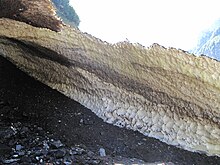Névé

Névé /neɪˈveɪ/ is a young, granular type of snow which has been partially melted, refrozen and compacted, yet precedes the form of ice. This type of snow is associated with glacier formation through the process of nivation.[1] Névé that survives a full season of ablation turns into firn, which is both older and slightly denser. Firn eventually becomes glacial ice – the long-lived, compacted ice that glaciers are composed of.[2] Glacier formation can take days to years depending on freeze-thaw factors. Névé is annually observed in skiing slopes, and is generally disliked as an icy falling zone.
Névé has a minimum density of 500 kg/m3, which is roughly half of the density of liquid water at 1 atm.[3]
Névé can also refer to the alpine region in which snowfall accumulates, becomes névé, and feeds a glacier.
See also[]
Notes[]
- ^ "Geol 33 Environmental Geomorphology". Hofstra University. Archived from the original on 2016-03-03. Retrieved 2017-12-19.
- ^ . Encyclopædia Britannica. Vol. 19 (11th ed.). 1911.
- ^ "Glossary of Terms". PhysicalGeography.net.
External links[]
 Media related to Névés at Wikimedia Commons
Media related to Névés at Wikimedia Commons
- Glaciology
- Water ice
- Snow
- Mountain meteorology
- Glaciology stubs